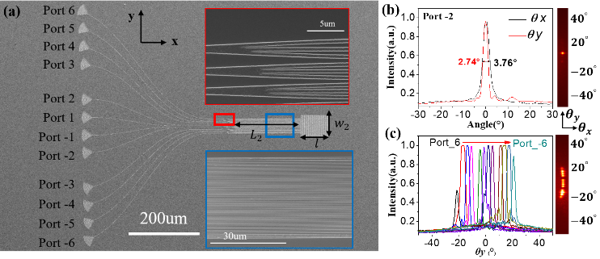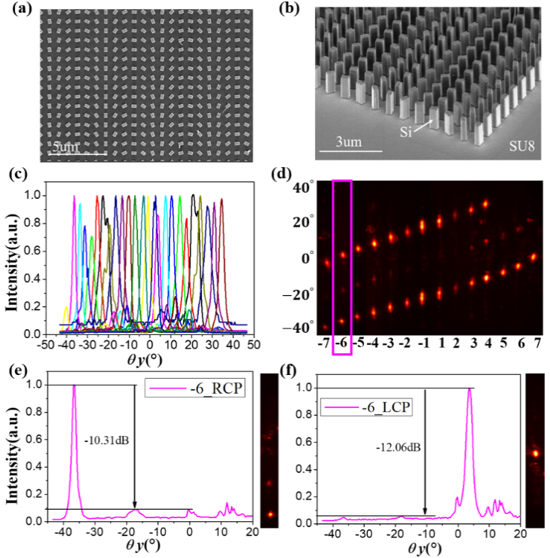With the rapid development of the information society, information perception technology with high speed, large capacity and low power consumption has become a significant trend of information technology. In particular, optoelectronic integration is expected to be an effective solution for high-performance, low-cost and mass-producible applications in communication and sensing. In the field of laser sensing, Light Detection and Ranging (LiDAR) enables relatively long-range and high-precision 3D imaging, which is critical for future applications in autonomous vehicles, drone detection and long-range machine vision, etc.
Optical phased array (OPA) based on waveguide integration is an important beam steering technology due to its high integration, stability, flexible scanning and compatibility with CMOS technology, which is considered as a promising technology to realize all-solid-state LiDAR. Recently, researchers have explored various photonic platforms, and silicon nitride(Si3N4) has become of interest for waveguides in integrated OPAs due to allowing for higher input power, larger transparency, and lower phase variation.
Compared with Si3N4, lithium niobate (LN) not only has the advantages of low propagation loss, wide transparent window and so on, but also is an excellent electro-optic Pockels material with a large coefficient. With the development of thin-film LN technology, the LN-on-insulator (LNOI) platform shows great potential for OPAs. Especially, phase modulation by using electro-optic effect of LN has great advantages in modulation speed and power consumption compared with others material platforms, such as thermos-optical effect and carrier injection of silicon. Therefore, it is a very promising OPA platform.
Nevertheless, the nanofabrication technology of LNOI waveguide is relatively complex and its compatibility with other nanostructures remains to be improved. Therefore, the development of LNOI devices with high quality is still challenging, making it less mature than SOI platform in the advance of integrated photonic devices. Recently, with the developing progress in the design and fabrication of LNOI waveguide, a series of important works have been realized, such as high-speed modulators, polarization controller, electro-optic comb generator, etc. However, it is still a great challenge for OPA technique to achieve beam steering with negligible crosstalk and a wide scanning field of view (FOV) based on lithium niobate waveguide array with small refractive index contrast.
To address the problems, a group led by Professor Tao Li from the College of Engineering and Applied Sciences at Nanjing University has proposed a port selective OPA (POPA) based on LNOI integrated platform and successful incorporated the metasurface design into OPA, which opens a new degree of freedom to achieve aliasing-free beam steering and FOV enlargement. The relevant research results were published in Photonics Research, Volume 10, No. 11, 2022 (Zhizhang Wang, Wange Song, Yuxin Chen, Bin Fang, Jitao Ji, Haoran Xin, Shining Zhu, Tao Li. Metasurface empowered lithium niobate optical phased array with an enlarged field of view[J]. Photonics Research, 2022, 10(11): B23).
In this paper, a non-periodic Jx-waveguide array is firstly adopted to demonstrate its capability to modulate the wavefront of in-plane beams. This engineered waveguide arrays function as an in-plane Fourier transform, which can convert the port-selected coupled light into a plane wave with specific angle and then radiate the light out of plane through the out-put grating. Further, a polarization-multiplexing metasurface is designed above the radiation grating to realize twice steering range by splitting the radiation beams into LCP and RCP, which effectively broaden the FOV of OPA as described in Fig. 1.

Fig.1. (a) Scheme of the metasurface-integrated POPA based on lithium niobate waveguide array and corresponding structural parameters of waveguide array. (b) Theoretical calculation results of wavefront modulation by Jx waveguide array according to different input ports.
As a proof of concept, researchers have developed POPA based on LN waveguide arrays without/with metasurface to realize horizontal and transverse beam scanning in communication band by port switching and wavelength sweeping. Figure 2 shows the experimental results of without metasurface, which realize the ±21.27°lateral beam scanning.

Fig.2. (a) Scanning electron microscopy (SEM) images of the lithium niobate POPA with 12 ports. (b) Measured FWHM beam size of far-field intensity pattern of the POPA. (c) Measured beam scanning angles ranging from -21.27° to 21.27° by switching input ports.
By introducing a metasurface with polarization multiplexing, the lateral scanning range of the POPA beam is almost doubled (up to 41.04°), as shown in Fig. 3. Moreover, the experimental results show a well aliasing-free beam steering that the peak-to-sidelobe ratio of RCP and LCP is -10.31dB and -12.06dB, respectively.

Fig. 3 The POPA integrated with metasurface. (a, b) The top and side view SEMs images of the integrated Si metasurface above the radiation grating. (c) The far-field radiation results by switching the input port, achieving a ±41.04°scanning range. (d) Measured beam profiles of the far-field experimentally. (e, f)Measured far-field emission pattern of right-circular polarized light and left-circular polarized light with No-6 input as described in (d).
Professor Tao Li said, "Although this work is still a "quasi-static" OPA based on port selection, which cannot achieve complete dynamic scanning, the electro-optical modulation can be employed in the future to control the phase of each waveguide, and we can obtain a truly high-speed modulation and low-power consumption LN-OPA chip."


